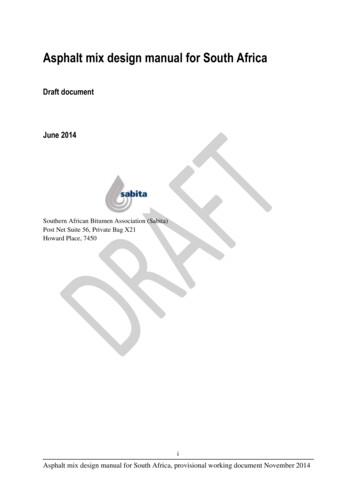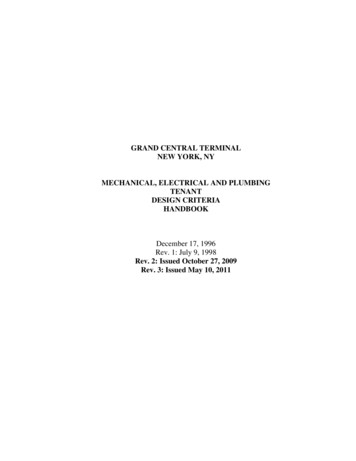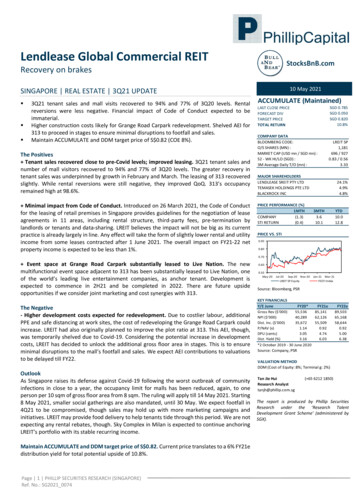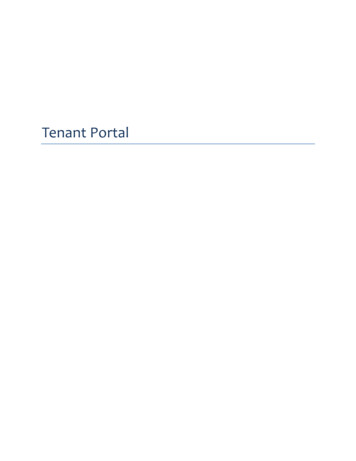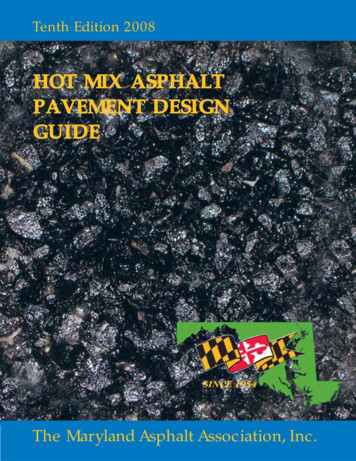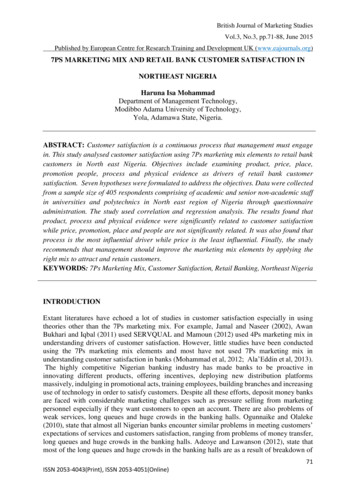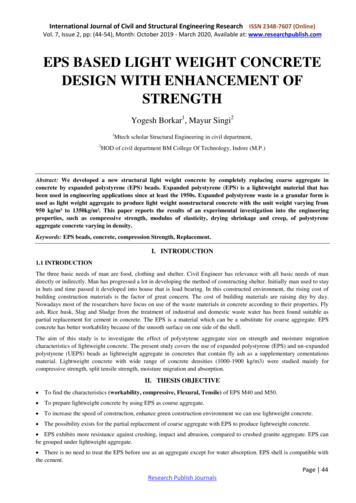
Transcription
Tenant MixMixCreating a Tenantand a Leasing PlanBeatrice MoutonRegional Director, JLLJuly 2014
Agenda1. Creating a tenant mix – the golden rules2. The leasing process3. Financials – key components4. Different approaches to tenant mixes5. Regional specifics of tenant mixes6. Examples of successful refurbishments and repositioning's7. New trends on the market8. Major challenges and mistakes to avoid9. Trends and impact of e-commerce on the tenant mix2
Creating a Tenant Mix- the golden rules
Creating a Tenant Mix - How?Golden Rules for a Successful Tenant Mix Understand profile of your Catchment AreaConsider Competitive Situation in your marketIdentify your potential MarketIdentify Shopping Behaviour of Customers Consider Critical Mass of the planned product(as the critical mass will differ whether it is aShopping Centre, Retail Park, Factory Outlet,Convenience, etc.) Determine your Competitive Advantages Create Unique Selling PointsFeasibility studyTenant mix4
Importance of a Feasibility Study – New developmentsIndepth market research is key to successfully develop anew retail project Market overviewSocio-demographic dataCompetition analysisProject DescriptionLocation & SWOT AnalysisCatchment area analysisSupportable floorspaceRetail Demand SurveyConcept / Lay outTenant MixERV5
Creating a Tenant Mix – New developmentEnvironment external &internal in terms of location ofthe future project: urban versus out of townlocation (pedestriancatchment versus cardestination), Visibility access by car & publictransport, future infrastructureimprovements parking (underground/surface car par/ deck park), vertical communication(where to place theescalators / travelators /lifts)Office AreaResidential AreaShopping Centre6
Market Study – Standing AssetsIndepth review of the Asset is key to ensure a successfulredevelopment, refurbishment or extension Market overviewCompetition analysisSWOT AnalysisCustomer ProfileTenant Mix & Positioning ReviewInventory of vacancies & lease expiriesTenant performance review (Affordability Ratio)Define short term to long term strategyRetail Demand SurveyLay out ReviewRevised Tenant Mix & PositioningFinancial conditions (ERV/Fit out contribution)Leasing Strategy7
Standing Asset –Redevolpment/Repositioning/ExtensionChanges in the environment external &internal in terms of location of theexisting centre : Socio-demographic changes(Population) Spending Power Access by car & public transport, Impact on parking Vacancyoccupancy Remodeling (under used area/matchretail demand) Vertical communication review Any future Infrastructureimprovements Tenant Performance review (In orout/ST versus LT strategy) RepositioningOffice AreaResidential AreaShopping Centre8
Creating a Tenant Mix – What & Where?Issues to be Considered Where to locate key anchors – food store, DIY, sport, leisure element(such as cinema), an electronic operator – ensure effective communicationand delivery zone9
Creating a Tenant Mix – What & Where?Issues to be Considered Fashion anchors – even distribution across the centre; create balanced flowof customers; activate dead-ends; Department stores vs. large fashionanchors (H&M, C&A, Zara, M&S, TK Maxx, New Yorker, etc.) – differentperception of brands subject to region / country; cultural differences andavailability of anchors should be taken into account10
Creating a Tenant Mix – What & Where?Issues to be Considered Other anchors such as multimedia/ bookstore (depending on the country i.e.FNAC, Empik, Matra, Dum Knihy, Pantha Rhei etc.) are tending to downsizetheir stores due to the impact of e-commerce in their sectors.Level 211
Creating a Tenant Mix – What & Where?Issues to be Considered Location of restaurants, cafes, foodcourt - Important issues: delivery, specific utilities,seating area, food courts need to anchored by strong brands i.e. McDonald’s, BurgerKing, KFC & proper seat-down restaurants i.e. Pizzeria; local culture & habits need tobe taken into account (size & type of kitchen as well as eating habits vary from countryto country); Identify special concepts to help differentiate the centre.12
Creating a Tenant MixIssues to be Considered Location of theme-oriented zones (clustering) – e.g. kids area, young fashion, familyfashion, formal clothing, sport accessories, premium segment, household goods,services, leisure, jewellery & accessories.Service lineDIYElectronic& SportCinemaHypermarketFashionFood Court areaService operatorsSport storesFashion and footwearLeisure componentFood CourtHealth & BeautyDIY store13
Location of theme-oriented zones – What & Where?Example 1 in Western EuropeFoodcourtA special area devoted to luxurybrands; a unique atmosphere wascreated due to the use of fancydecoration and finishingsFashion anchors /Department storeRestaurants
Location of theme-oriented zonesExample 1 in Western EuropeLuxury Village
Location of theme-oriented zonesExample 2 in Turkey
Location of theme-oriented zonesExample 2 in Turkey 4-level scheme – 2 level in the basement and 2 level above ground (GF & FF) Each floor has a specific positioning (from mass to luxury) Luxury brands located on the first floor in a shopping villageLuxury VillageLeisureelementLevel 1
The leasing Process
Life cycle of a shopping centreSource: JLL, based on Lowry, J.R., The Life Cycle of Shopping Centres, Business Horizons, 199719
Leasing Process: Timescale – Phase INegotiations startsFood operatorDIYElectronicCinemaKey fashion anchors( 1,000 m2)Department storesSportKidswear/ToysMultimedia(12 – 18 months)(12 – 15 months)Opening time1 2 3 4 5 6 7 8 9 10 11 12 13 14 15 16 17 18 19 20 21 22 23 24Works with architects –final layout20
Leasing Process: Timescale – Phase IINegotiations startsFood operatorDIYElectronicCinemaKey fashion anchors( 1,000 m2)Department storesSportKids accessoriesMultimedia(12 – 18 months)Shops 500 m2ServicesShops 500-1,000 m2(2–10 months)(10 – 12 months)End of negotiations(8 – 12 months)Foodcourt(12 – 15 months)Opening time1 2 3 4 5 6 7 8 9 10 11 12 13 14 15 16 17 18 19 20 21 22 23 24Works with architects –final layoutThe economic crises lengthened the leasing process21
Leasing – The Tool Kit – The essentials Research in place Leasing strategy Approved Rental Income Service Charge & Marketing budget in place Standard HOT document Standard Lease Contract in place Technical Specifications / Tenant Manual Marketing tools-Floor PlansPresentationBrochureMarketing budget to attend specialized fairs i.e. MAPIC, Retail Connect, etc.ModelKeep an open mind, remain flexible!22
KeyFinancials - toComponents
Financials – Key ComponentsUnderstanding the product, the environment & the retailerskey to achieve a sustainable rental income Budget setting - ERV influenced by 4 key factors Size – Anchors Rental levels tend to be lower, In line boutiques higher Activity Fashion/Footwear/H&B/Accessories/Services/Food Courts –tend to pay better rents Food/Multi media/Sports/Household goods/Toys/Discounters rent sensitive low margins Leisure – Costs sensitive, significant upfront investment Turnover & Margins – Direct correlation between turnover & rent Fashion/Footwear operator rent should not exceed a certain % of T/O i.e. 8% Department store: Rent not to exceed i.e. 4% to 5% Food operator – Rent not to exceed i.e. 1.5% / 2.5% of T/O, Volume / Margins Multimedia - Rent not to exceed i.e. 3% to 4% etc. Location Floor Corner/Central location/Dead end Next to vertical circulation/Parking, main entrance ,Visibility etc24
Financials – Key ComponentsUnderstanding the product, the environment & the retailerskey to achieve a sustainable rental income Budget setting- Service charges Anchors - Discounted service charges Food & Leisure anchors: Lowest contributor Fashion/Department Stores/Sport/Multimedia/Toys/Household anchors: In line boutiques: full service charges- Marketing fee Anchors discounted or in certain cases such as with Food or lesiure operators non existent or even symbolic In line units contributing to the full amount- Fit Out budget- Apply to anchor tenants- In line units when market proves difficult or to attract specific local operators, units with basic fit out can be provided- Lease term: Subject to country legislation Central Europe tend to be 5 to 10 years.25
Different Approaches toTenant Mixes
Merchandise Mix Breakdown: Urban MallTypical Space Distribution Focus on fashion & accessories Importance of food store & leisure component (Cinema, Kidsplay area, Bowling, etc.) Careful selection of the food component (type and size) DIY element not a priority27Source: JLL, June 2014
Merchandise Mix Breakdown: Urban MallExampleTraffic generators and less profitable tenants (i.e. food, sport, electronics,health&beauty, multimedia, fitness, services, etc.) to be located in the basement.Food anchorMultimediaanchorService areaShoe anchorShoe anchorToy storeShoe anchorSport anchorLevel -228
Merchandise Mix Breakdown: Urban MallExampleGround floor – most valuable, most visible, most desirable, most expensiveGF sets the atmosphere of the shopping centre – tenant mix to be considered carefully to secureand attract high profile brands, which shall set the positioning and image of the whole centreFashion anchorsevenly distributedover the centreLevel 029
Merchandise Mix Breakdown: Suburban RetailComplexTypical Space Distribution Car destination mixed with public transport & in some cases pedestrian catchment Catchment area up to 30 minutes drive Critical mass is essential, wide offer with strong anchors to capture clients from furtherafield – a hypermarket, a DIY store, an electrical store, furniture store, a sport store Careful selection of unique anchors from the fashion & footwear sector Leisure component, restaurants and cafes shall be carefully analysed and selectedSource: JLL, June 201430
Merchandise Mix Breakdown: SuburbanRetail ComplexExampleFood anchorService lineDIYFashion AnchorsFashion & ShoesCinema31
Merchandise Mix Breakdown: Convenience CentreTypical Space Distribution Smaller catchment – max 5 to 10 minutes walk, 15 minutes by car, Requires a pedestrian catchment Smaller in size Main anchor – food operator, usually smaller format with a drugstore Potentially a fitness centre and/ or a kidsplay area High proportion dedicated to servicesSource: JLL, June 201432
Merchandise Mix Breakdown: Convenience CentreExampleFashion storesSupermarketFitness clubService operatorsKids’ afeRestaurantPharmacy33
Different Approaches to Tenant Mix: Retail ParkSuburban / out of town location – usually no pedestrian catchmentNeed critical massWider catchment areaCar destination – easy access by car – location at major roads / hubsEntrance to each unit directly from the car parkTheme – oriented profileVery focused on food, DIY, Sport, Electronics and other HH GoodsSize requirements for anchors: 8,000-15,000 m2 for Hypermarket; 7,000-15,000 m2for DIY; 1,000-3,500 m2 for Electronics; 1,200-4,000 m2 for Sport Kidswear, multimedia and fashion subject to being able to attract enough brands tocreate an attractive tenant mix 34
Different Approaches to Tenant Mixes: Retail ParkExample35
Different Approaches to Tenant Mixes: Factory Outlet Edge or out of town locationCar destinationNo pedestrian catchmentWider catchment area up to 1h 30 minutesSmaller size of anchors (approximately 500 m2) as well as smaller unit size for therest of the mallTypically anchored by Sport and Fashion brands i.e. Puma, Adidas, Nike, Mango,Benetton, etc. (Subject to positioning)Positioning differ according to the countryNo food anchor (can be nearby but not necessarily incorporated in the centre)Small food courtPossibly leisure element – depending on the country and location (i.e. La ValléeVillage near Euro Disneyland in Paris, Outlet Park in Szczecin in Poland)36
Different Approaches to Tenant Mixes: Factory OutletCEE Example37
Different Approaches to Tenant Mixes: Factory OutletExampleBicester VillageLondon38
Regional Specifics ofTenant Mixes
Tenant Mix Structure: Regional DifferencesKey DriversMerchandising mix measured by GLA 40
Tenant Mix – Geographical Aprroach:Catering ComponentCatering component in some countries act as an anchor South of Europe – greatimportance of restaurants &cafes zone in the scheme(up to 50 – 60 operators)The whole level is devoted tofoodcourt areaCinema Seated restaurants as well asfood court units with acommon seating area Usually, all catering amenitiesconcentrated in one part,close to a leisure componentGlass facade - Panoramic view41
Tenant Mix – Geographical Approach:Catering ComponentGlass facade - Panoramic view from the foodcourt area42
Tenant Mix – Geographical Approach:Leisure Component Growing importance of leisure component, especially in WesternEurope Act as traffic-generators Becoming a key differentiator for shopping centres – offering anattractive tenant mix is not enough any more Western & Southern Europe - up to 15,000 – 20,000 m2 – multiscreen cinemas, bowling, playground for kids, food court, fitness c,games & gambling, etc. but also go-carts, covered snow tracks (e.g. Snow Zone in MadridXanadu), swimming pools, „edutainment” centres – Kidzania, etc.43
Tenant Mix – Geographical Approach:Leisure Component44
Geographical Approach to Tenant Mixes –Leisure ComponentExample in Central Europe45
Geographical Approach to Tenant Mixes –Leisure ComponentExample in Central EuropeMagic City:- Lucid Music Club- Pure Fitness Club- Inca Play – kidsplay areaAdditionally in the scheme:- Level 3 – Go-cart area- Level 2 – Dance schoolLevel 4
Geographical Approach to Tenant Mixes –Leisure ComponentExample in Western EuropeEntrance to the shopping centreShopping centre A riverside setting(environmental feature) In town location Next to the local high street(pedestrianised) A shopping, restaurants &cafes, entertainment, andrelaxation destination A beach at the riverside duringthe summer seasonCinemaFashionanchors
Geographical Approach to Tenant Mixes– Leisure ComponentExample in Western Europe8000 m22 levels2014/2015
Geographical Approach to Tenant Mixes– Leisure ComponentExample in Southern EuropeSignificant portionof space devotedto leisure andrestaurantcomponentsRestaurant areaLeisure areaRetail park
Geographical Approach to Tenant Mixes– Food anchorExample in Southern EuropeHypermarket anchorTraditional food market
Different Approaches to Outlet CentreExample in Western Europe High end tenant mix Open air concepts – shopping village51
Different Approaches to Tenant Mixes:Factory OutletCEE ExampleSupermarketService operatorsFASHIONOUTLETSTORESKids equipmentCinemaFoodcourt52
Different Approach to Outlet CentreExample in Central Europe Mid-market tenant mix, dominating casual and sport fashion Roofed buildings – resulting from weather conditions53
Examples of SuccessfulRefurbishments and Repositionings
Case I: Refurbishment – Situation Before Ground and First floors were looking tired; Tenant mix was stagnant and not differentiating the centre; Poor communication to the second floor (Entertainment & Food Court);55
Case I: Refurbishment – Situation AfterReplaced stairs with anescalator and spread NewYorker up to to 2nd floor Full repaint of centre, change of lighting, flooring and columns to create more lightand a fresher look. Added a number of relax / rest zones; Tenant mix was refreshed with a number of new tenants (New Yorker over 2 levels)including tenants with a higher positioning, free kids play area; Improved communication by replacing stairs with an escalator to 2nd floor;56
Case Study II: Successful Extension & RefurbishmentKey facts:Opening date:Original scheme size:Current scheme size:No of units:Anchor tenants:Market situation:October 199621,000 m2 GLA32,000 m2 GLA (52% GLA increase)160Alma delicatessen, RTV Euro AGD, Marks & Spencer, Zara, Empik,Reserved, KappAhl, H&M, Cubus, New Look, Smyk, Pure JatomiFitnesslocated in affluent residential area, along main arterial roadconnecting Gdańsk, Gdynia and Sopot cities, with good visibility(300-meter road frontage)57
Case Study II: Successful Extension & RefurbishmentActions taken Shopping centre extended by 11,000 sq m Car park extension by 400 additionalparking spaces Refurbishment of the whole centre (shopfronts, toilets, etc.)Results The retail offer and critical mass has beensubstantially strengthened by 70 new stores GLA increased by 52% New and attractive tenants were introduced,including Pure Jatomi Fitness and Michael Kors(first in the city). The centre has improved its tenant mix and isnow targeting a wider pool and more affluentcustomers Final look of the centre improved after the totalmakeover58
Case Study II: Successful Refurbishment& RepositioningBeforeLevel 0AfterExtended shopping areawith new brands and newdecked car parkLevel 059
Case Study III: Successful Remodeling– Food CourtBeforeTraditional food courtLooking tired, dark & oldfashion60
Case Study III: Successful Remodeling – Food CourtAfterEnlarged & renovated food courtLooking fresh, modern, light &overall more inviting61
Case Study IV:Successful Refurbishment & RepositioningKey facts:Opening date:Scheme size:No of units:Anchor tenants:Market situation:April 200330 000 m2 GLA100Carrefour, RTV Euro AGD, H&M, Reserved, KappAhl, Cubus, Takko,Smyk, Empik, Delta Sport, CCC, Rossmann, Douglascentre with established market position and loyal customer base, locatedalong one of the major arterial roads in the city with strong competitor inthe city centre62
Case Study IV:Successful Refurbishment & RepositioningActions takenResults The centre was repositioned from low& mid-market to strong mid-market The centre reinforced its position in a midmarket segment 30% of the tenants from fashion andshoes categories were exchanged The retail offer was enriched with new andattractive brands: Cubus, Mohito, Sizeer, etc. The food court was upgraded The food court was upgraded and cateringoffer refreshed through introduction of newbrands Nasz Naleśnik and awaited by thecustomers KFC restaurant The local bowling operator exchangedfor a multiplex The scheme was refurbishedinternally (including toilets, commonareas, signage system, furniture,plants, etc.) Leisure offer was improved after theopening of 7-screens Helios cinemareplacing the local bowling operator Image, quality, internal circulation and designof the centre improved after the refurbishment63
Case Study IV:Successful Refurbishment & Repositioning64
Case Study IV:Successful Refurbishment & RepositioningBeforeAfter65
Case Study IV:Successful Refurbishment & RepositioningPlanned extension by 10,000 sq m (additional 40 stores) – opening Q3 201566
New Trendson the Market
Case Study I: Communication interchangesBeforeOld, ruined railwaystation68
Case Study I: Communication interchangesAfterModernized railwaystation connected to anew shopping centre69
Case Study I: Communication interchangesAfterLevel -1Level 0Bus stationDirect access to theshopping gallery frombus & railway stationsRailway station70
Case Study II: High Street71
Case Study II: High Street72
Case Study III: Retail in ResidentialRetail areas are locatedon the ground floors ofnew housing to servicethe residents, focused onservices73
Major Challengesand Mistakes to Avoid
Challenges – Verticality How? Focus on a compact lay out with limited verticality - 2 to 3 floors maximum potentialcombination Basement/GF/FF or GF/FF/SF Verticality may works in the case of a sloping site as it allows to create “street access”on 2 or 3 levels Another way to overcome verticality, deck car parks to feed the upper levels Lower floor usually dedicated to food & services Last floor tend to be dedicated to leisure & entertainment i.e. Cinema, Bowling,Fitness Centre etc. Leisure component acts as a complement to a retail scheme & strengthen the centreas a shopping & leisure destination With the rapid development of internet sales, the leisure component is growing inimportance, another way to differentiate from competition & lure customers intoshopping centres75
Multi-Level CentreMajor Challenges Distribution of anchor tenants acrossthe levels in order to animate theupper floors Anchor tenants on 2 levels tocirculate customer flow betweenlevels Parking area – located in upperfloors to ensure circulation ofcustomers76
Multi-Level CentreExampleSituation:Level 01 fashion anchoracross 3 levels 3-level retail scheme sufferinghigh vacancy rates, especiallyon the upper floorsLevel 1Action taken:Educational games5D CinemaLevel 2Restaurant Leisure & entertainment werebrought to the upper-floors(cinema, bowling,restaurants)77
Major Mistakes in LayoutsDead EndsLack of anchor tenants to capture customer flowDead endToo many small unitsLimited number offashion anchorsHypermarketEntrances78
Major Mistakes in Layouts – Wrong Food OperatorDiscounter, Hypermarket, Supermarket or Delicatessen?Mistake in layout resulting mostly from mistake in the positioning!Delicatessen store better suits the clientelethan formerly trading supermarketFood operator too small with the wrongpositioning to generate customer flow79
Major Mistakes in LayoutsAnchor Tenants DistributionLeisurecomponentVacant units Special interest destination –e.g. medical centre – notadequate for the area Upper level of the scheme –lack of anchor tenants togenerat customer flow Blank wall Poor visibility, with units setback Poor vertical circulation Concentration of small units onone side vs. anchor tenants onthe other Foodcourt too large80
Major Mistakes in LayoutUneven Distribution of AnchorsConcentration of anchors in onecorner next to the main entranceFood AnchorPiazza and main entrance81
Major Mistakes in LayoutsComplex Layouts Two separate wings Lack of visibility from each wing (customers cannot see the other wing and all itstemptations Poor central area breaking the customer flow82
Major Mistakes in LayoutsDifficult access Ground floor split into 2 distinctive areas Limited access to food operator on GF floor or via the FFLevel 0Level 0Food operatorLevel 1Ways of access83
Major Mistakes in Layouts - Summary VerticalityDead endsPoor distribution of anchors across the centreWrong positioningImpeded communicationSegregated areas particularly applicable to extensionsPoor sight line i.e. columns hindering the visibilityPoor vertical communicationLack or poor location of escalators not facilitating thecirculation within the centre84
The Impact of E-Commerce E-commerce vs. Traditional Retailing – Allies or Enemies?
Access to InternetPercentage of households with internet access have doubledwithin the last 5 years20132008EU28: 60%EU28: 79%Source: Eurostat, 201486
Share of e-commerce in retail salesSource: Centre for Retail Research, 201487
General challenge: Online-retail and its impactsExample Germany: Current market shares: circa 8% in 2014Markets sharesInternet salesCatalog sales/mail orderCounter retail ) 2013/2014 PrognosisSource: GfK GeoMarketing GmbH, June 2013
General challenge: Online-retail and its impactsExample Poland: Development of Internet sales (billion otalOgółem402001200220032004Source: GfK GeoMarketing GmbH, June 201320052006200720082009201020112012
General challenge:Online-retail impact on the fashion sectorFuture sales channels - Possible turnover shares for a Fashion-RetailerBy 2022 On line direct will amount to circa 25% of Fashion retailer‘s turnover25%8%13%25%80%Source: GfK GeoMarketing GmbH, June 201330%
Why online shopping?ComfortableTime saverComparativeShoppingMoney savingOnly accesstomerchandiseImpulsShopping91Source: Kangoo.pl, 2009; E-Handel Polska Report 2009 by sklepy24.pl
Main drivers of e-commerce in Poland Increasing number of households equipped with computers, broadband internetaccess and smartphones. Growing consumer confidence to internet and e-commerce: Improved delivery! Internet allows to reach everyone and everywhere, beyond traditional catchmentareas. Dominance of two categories: furniture and household appliances, electronics. Large share of the auction sites in the volume of online trade Internet allows for price comparisons: consumers are moreeducated than ever before (ceneo.pl, skapiec.pl, tanio.pl, poile.pl). Web as a social shopping network: platforms for gathering groupsof clients and buying products in bulk at discount prices (gruper.pl,fastdeal.pl, cuppon.pl, groupon.pl).92
Major barriers to the development of e-commerce Lack of confidence in ordering goods from a distance Lack of trust to make payments online Costs of returning unwanted or damaged goods A small percentage of regular heavy internet users doing online shopping. Fragmentation of the market Lack of adequate legislation93
InnovationsVirtual reality storesPolyvore.comQR CodeMetro station in Korea – e-supermarketAmazon inboxes94
InnovationsFacebook applicationsSupermarket crowdsourcessuggestions for local productsMore mobile applications95
Dealing with High Vacancy Ratesor Short Term Expansion96
What does it Mean forTraditional Retail ?
Examples of retail chains strategies1. Traditional brands expands on the internet (brick & click).2. Internet brands expands into traditional trade.3. Brand withdrawals from traditional commerce to sell exclusively on theInternet.98
Impact on shopping centers Large shopping centers to remain popular, but need to be repositionedtowards services that cannot be purchased online. Reduction of electronicstores and home furnishing area. The growing role of convenience centers. Conversion of stores into showrooms and pickup points of goods orderedonline. New ways of spending free time - more socializing. The use of new technologies - social media, mobile devices. More sensation (smell, touch, taste “the Latte factor”). Increasing appeal of “Retail Therapy” (non shopping function)99
Impact on shopping centers Flexible lay out required to adapt to the changing retail demand Higher vacancies in shopping centers Polarization between prime and secondary centers Centers in good locations will retain clients. Back to basics - location, accessibility, social responsibility, better tenantmix, customer profile, the environment. Boxparks – Pop-up stores, exclusive shopping opportunities, frequentchanges in the collection - making „noise” Interactivity between shopping centre & client100
Online retailing101
Putting into Practice
Case Study 1- Ground FloorHypermarketMain entrance103
Case Study 1 – First FloorAccess from Car Park104
Case Study 2Surface Car Park Park House not connected105
Case Study 2106
Thank you!COPYRIGHT JONES LANG LASALLE IP, INC. 2014
ICSC European PartnersICSC Global PartnerICSC European Partners
Negotiations starts (12-15 months) Food operator DIY Electronic Cinema Key fashion anchors ( 1,000 m2) Department stores Sport . Food operator -Rent not to exceed i.e. 1.5% / 2.5% of T/O, Volume / Margins Multimedia - Rent not to exceed i.e. 3% to 4% etc. Location loor F

